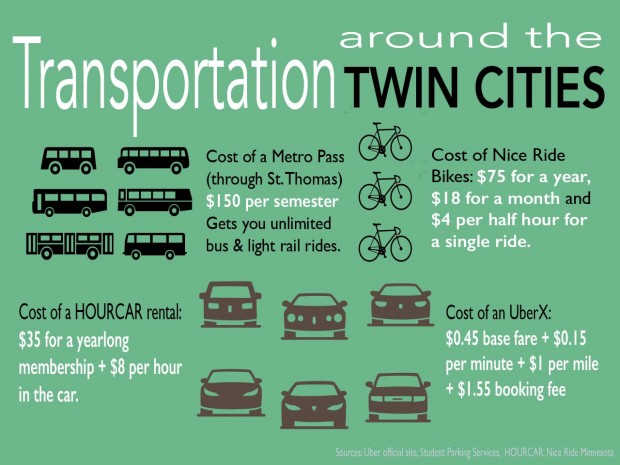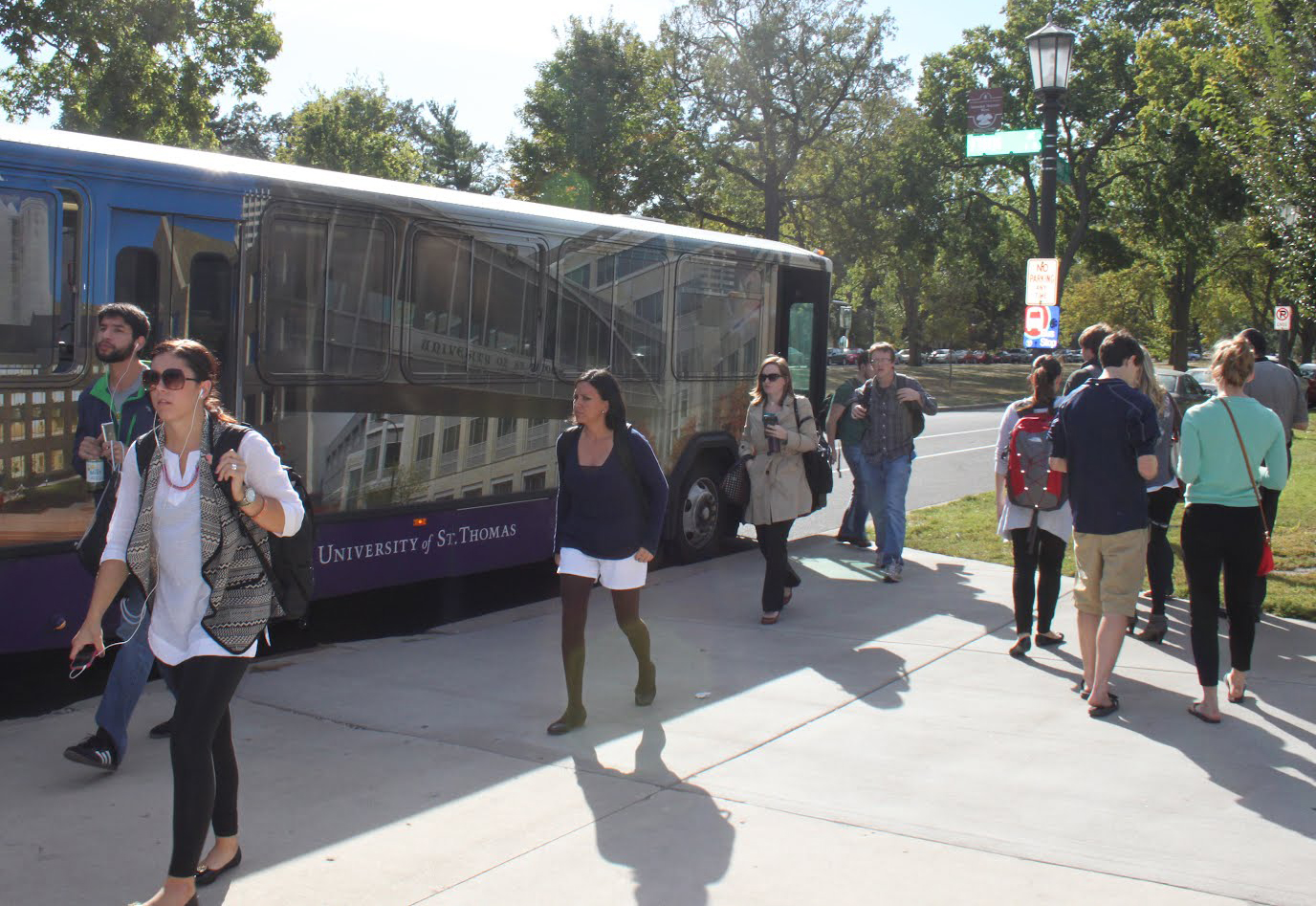
Transportation and parking are daily concerns for the St. Thomas community.
Over two-thirds of students and faculty commute to campus, according to the school’s website, but how they commute is another question. There are several options available to make getting around town easy and affordable.
Public Transportation
William Carter III, special projects manager for Public Safety, believes that using public transportation is a great way for students to immerse themselves in the Twin Cities scene.
“It’s an opportunity to see other people, meet other people and be a part of the community in a different type of way,” Carter said. “It gives you the chance to look around and see what’s available.”
St. Thomas offers its own shuttle bus between the St. Paul and Minneapolis campuses for students. This free option is the easiest way for Tommies to move between the two campuses, as the shuttle runs every 20 minutes on weekdays from 6 a.m. to 11 p.m..
The shuttle doesn’t run as frequently on weekends — it departs every half hour on Fridays after 6 p.m., all day on Saturdays, and doesn’t run at all on Sundays. Still, Carter thinks it is the most convenient option for students.
“During the school year, take the shuttle,” Carter said. “It takes you from point A to point B nonstop.”
While the shuttle is optimal for getting to the Minneapolis campus, other modes of transportation can get you to different parts of the city.
Metro Transit offers buses and light rails all over St. Paul and Minneapolis, and students can take advantage of discounts to cut costs. St. Thomas offers a college pass for $150, which gives unlimited rides for an entire semester.
Several bus stops are located around campus, including many on Summit, Cretin and Cleveland avenues. Buses typically takes no longer than 20 minutes to arrive at any given stop.
Senior Sarah Horns said taking the bus has several advantages.
“I like taking the bus over driving. I don’t have to worry about finding parking or driving in heavy traffic,” she said. “I prefer it over biking if I’m going a long distance or don’t feel safe biking on busier roads. The bus also has the advantage of being more eco-friendly than if I were to drive somewhere alone.”
Train
The Green Line light rail train runs along University Avenue from downtown St. Paul all the way to Target Field in Minneapolis. It makes stops every 10 minutes during the day, every 10-15 minutes during evening hours and every 30-60 minutes at night, according to the Metro Transit website.
Car
If you don’t have your own car, HOURCARs are available at both the St. Paul and Minneapolis campuses. HOURCAR allows members to rent a car for a period of time and is a useful service for convenient for quick trips, such as runs to the grocery store. It costs $35 for a yearlong membership, plus $8 per hour in the car according to their website.
HOURCARs are located on the St. Paul campus in Lot M by McNeely Hall and Lot N by the Facilities and Design Center and O’Shaughnessy Science Hall.The Minneapolis campus has an HOURCAR in Lot 3.
Taxi apps such as Uber and Lyft are popular among college students, and they often offer affordable rides to wherever they need to go.
UberX, the cheapest option Uber offers, has a base fare of 45 cents, plus 15 cents per minute, $1 per mile and a $1.55 booking fee, according to the Uber website. It also has a minimum fare of $6.05. For some context, a trip to the Skyway Theatre in Minneapolis from the St. Paul campus during non-peak traffic hours would cost approximately $9 to $15.
Senior Tyler Wolfe took Uber to and from work for about a month when his car broke down last February. He said the service can help out in a pinch.
“It’s a pretty cost-efficient way to get around for someone who doesn’t have access to a car. It usually cost me around $10 to go about five miles,” he said.
Getting bigger cars by using services like UberXL or UberSUV will increase prices, but you can split the fare between several riders in your group.
When rides are in high demand, taxi apps implement surge pricing, which multiplies the cost of the ride by a predetermined amount. This can make rides more expensive than expected on busy nights like weekends.
“Surge pricing may be a smart business strategy, but sometimes it feels like theft. A lot of times the price of your ride will be much higher than you thought it would be,” Wolfe said.
A fare estimator can give a sense of how much a ride might cost.
Bike
For those who favor a more environmentally-friendly mode of transportation, biking can be a great option. Not only does it provide exercise, but it is accommodated well in the St. Paul area.
Nice Ride bikes around the cities allow you to rent a bike on a pay-per-ride basis. A single half hour ride costs just $4, according to their website. You can hop on one of the green bikes for a quick trip when you only need to go a couple of miles.
The St. Paul campus has several bike racks to make biking to class a viable option. A Nice Ride station is located
near the Anderson Student Center.
No matter your preference, Carter recommends trying something new when it comes to transportation, because the experience can be rewarding.
“Experiment with it. Give it a try. Recognize that it provides more options for students, not only those that don’t drive. Getting the experience and going places in the Twin Cities will enhance your education,” he said.
Spencer Flaten can be reached at flat6148@stthomas.edu

